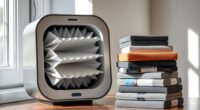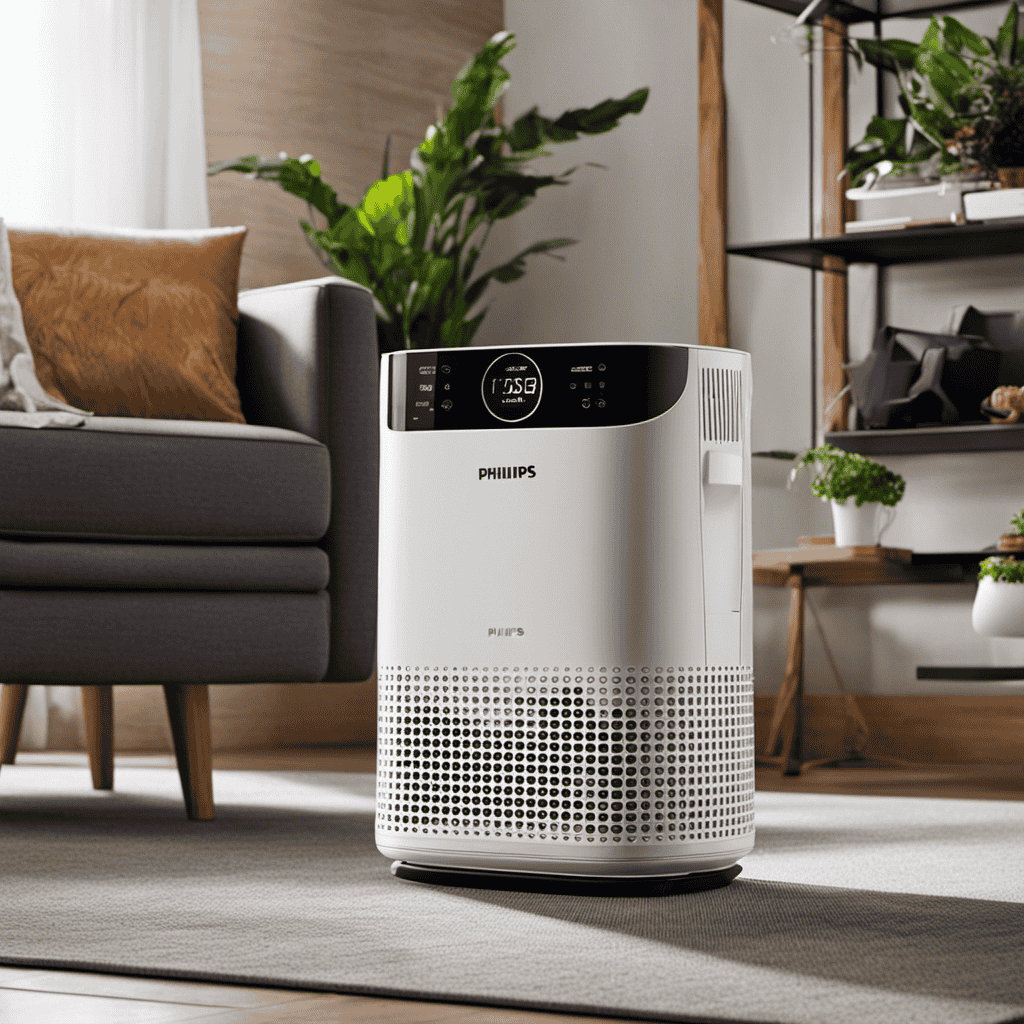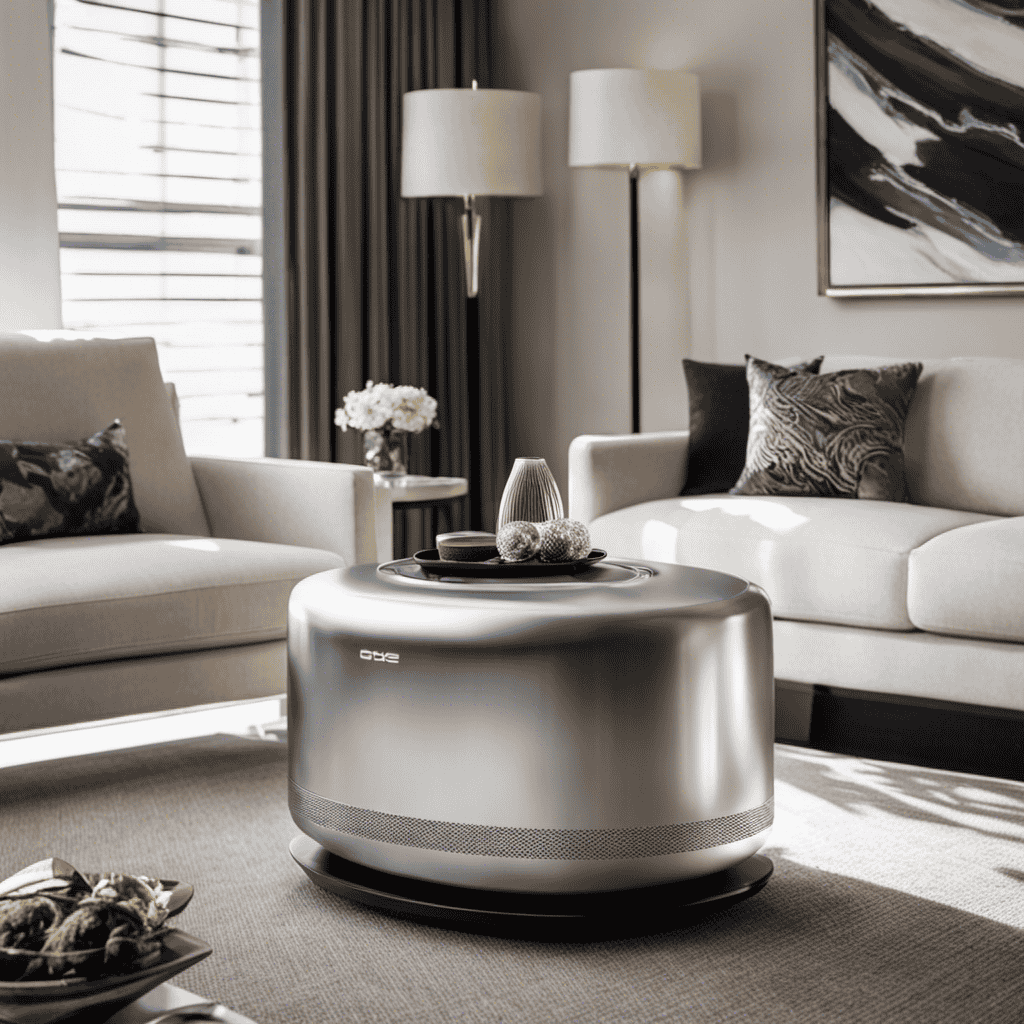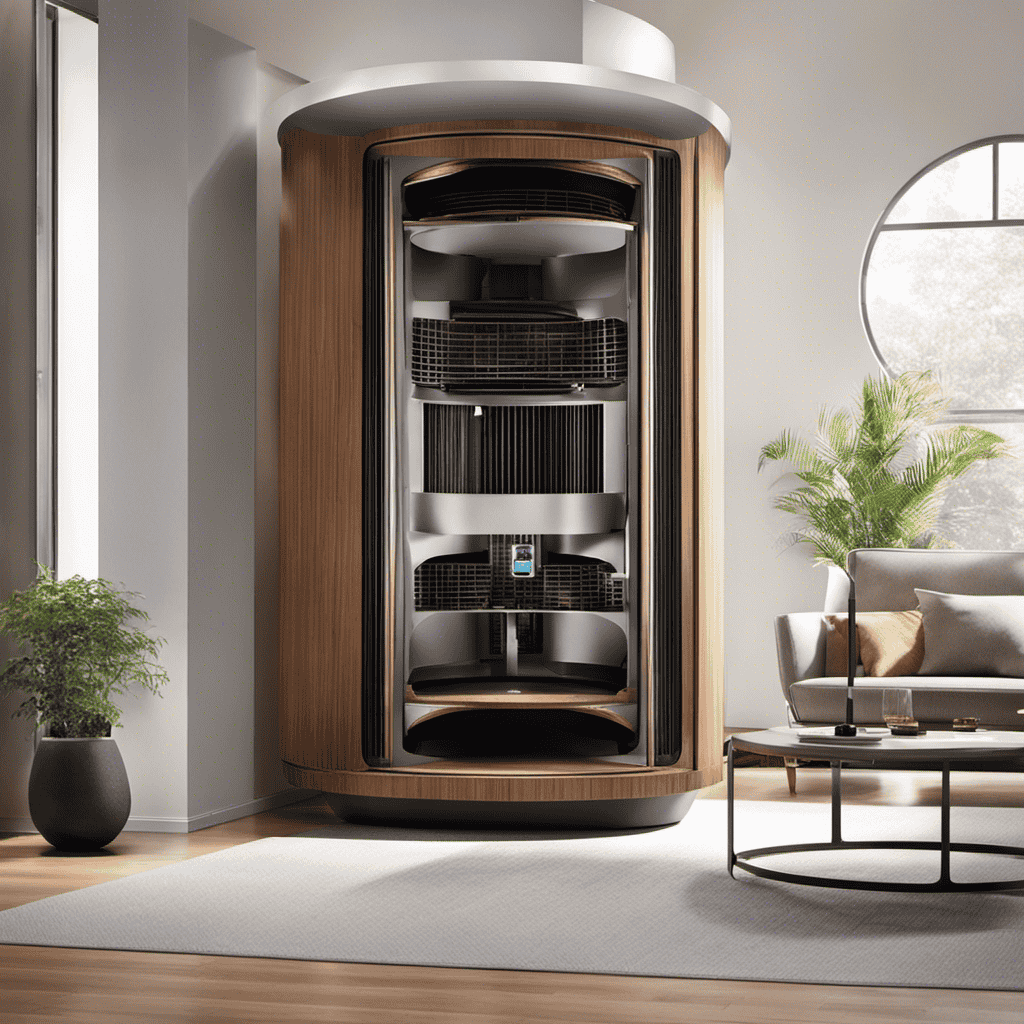During wildfire outbreaks, protecting indoor air quality is vital to avoid harmful smoke particles and gases. Use an air purifier with True HEPA filters to capture tiny particles like soot and pollen, and activated carbon filters to absorb gases and odors. Keep windows and doors closed, and operate the purifier on high settings during smoky days. Regular maintenance and proper placement guarantee peak performance. Keep exploring for more tips on creating a safe, healthy indoor environment during wildfires.
Key Takeaways
- Use air purifiers with True HEPA filters and activated carbon to effectively remove smoke particles and gases indoors.
- Keep windows and doors closed during wildfire smoke events to prevent outdoor pollutants from entering.
- Regularly replace filters and maintain your air purifier to ensure optimal performance and indoor air quality.
- Position air purifiers centrally and away from obstructions to maximize air circulation and filtration efficiency.
- Monitor indoor air quality with reliable sensors and operate purifiers on high or turbo mode during smoke events.
Understanding the Impact of Wildfire Smoke Indoors

When wildfire smoke drifts indoors, it can quickly compromise the air you breathe. This pollution contains harmful particles and chemicals that threaten wildfire health and your overall well-being. Breathing in smoky air can cause respiratory issues, aggravate asthma, and lead to other health problems. Indoor air safety becomes a concern because smoke particles easily infiltrate your home through windows, doors, and ventilation systems. Even if you’re not directly exposed outdoors, the lingering smoke indoors can be just as dangerous. Recognizing how wildfire smoke impacts indoor air quality is vital for protecting yourself and your loved ones. Taking steps to minimize indoor smoke exposure helps safeguard your health, especially during wildfire seasons when smoke can persist for days or weeks.
Key Features to Look for in Air Purifiers for Smoke Filtration

To effectively remove wildfire smoke from indoor air, it is vital to choose an air purifier equipped with specific features designed for smoke filtration. Look for units with a True HEPA filter, which captures tiny particles, and an activated carbon filter to absorb gases and odors. Additionally, check for user-friendly features like filter replacement schedules to guarantee consistent performance without guesswork. Regular maintenance is key to keeping your purifier functioning at its best, especially during smoky conditions. Consider models with indicator lights that alert you when filters need changing. These features not only improve air quality but also simplify upkeep. Selecting an air purifier with certified performance can ensure optimal efficiency in smoke removal. Incorporating air quality standards into your decision-making can further help in choosing the most effective device for your needs. Being aware of filter replacement guidelines can help you maintain peak performance and safeguard your indoor environment. Incorporating mindfulness techniques into your routine can help manage stress caused by wildfire events and improve overall well-being.
How Air Purifiers Remove Harmful Particles and Gases
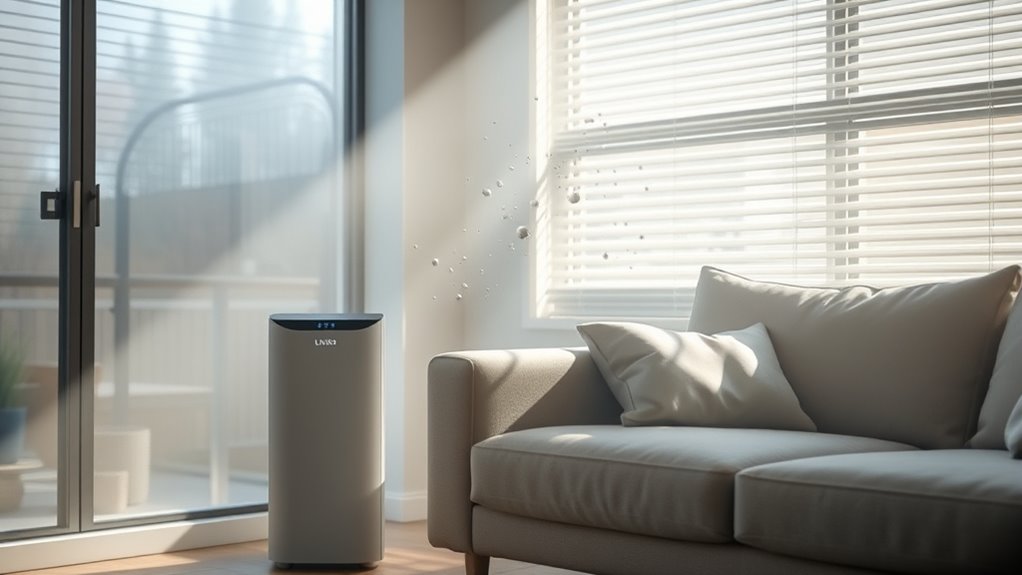
Air purifiers combat wildfire smoke by employing advanced filtration technologies that target both harmful particles and gases. Electrostatic filtration uses charged plates or fibers to attract and trap tiny particles like soot and pollen, ensuring cleaner indoor air. Activated carbon layers are essential for absorbing gases, odors, and volatile organic compounds released during wildfires. These layers effectively neutralize harmful chemicals, preventing them from circulating in your home. Additionally, understanding cybersecurity vulnerabilities during emergencies underscores the importance of maintaining secure devices to protect personal information while managing air quality devices. Incorporating proper maintenance and timely filter replacements enhances the overall effectiveness of air purifiers. Regularly inspecting and replacing filters ensures optimal filter performance, especially during periods of heavy smoke exposure. Proper air quality monitoring can help detect pollutant levels indoors and guide necessary actions, making sure your home remains safe and comfortable. Being aware of automation’s role in business intelligence can also inform how you manage your smart devices for better safety and efficiency. Combining both methods provides all-encompassing protection against wildfire-related pollutants.
Tips for Proper Use and Maintenance of Your Air Purifier

Regularly checking and replacing filters is essential to keep your air purifier functioning effectively. Follow the manufacturer’s instructions for filter replacement schedules, typically every 3 to 6 months. Delaying filter changes can reduce efficiency and compromise air quality. When replacing filters, ensure you use the correct type recommended for your model. Proper placement tips also matter; position your purifier in a central location away from walls and obstructions to maximize airflow. Keep it on the recommended setting for wildfire smoke situations, often high or turbo mode. Regular maintenance not only improves filtration but extends the device’s lifespan. Cleaning or replacing filters as needed guarantees your purifier continues to effectively remove wildfire smoke particles and gases from your indoor air. Additionally, filter maintenance is crucial for ensuring continued effectiveness and air quality in your home. Proper device placement can significantly enhance its ability to filter pollutants efficiently. To maintain optimal performance, routinely monitor the air quality indicators and replace filters promptly when indicated. Maintaining clean filters and proper device operation is also vital in sustaining air purifier efficiency during wildfire events.
Additional Strategies to Improve Indoor Air Quality During Wildfires
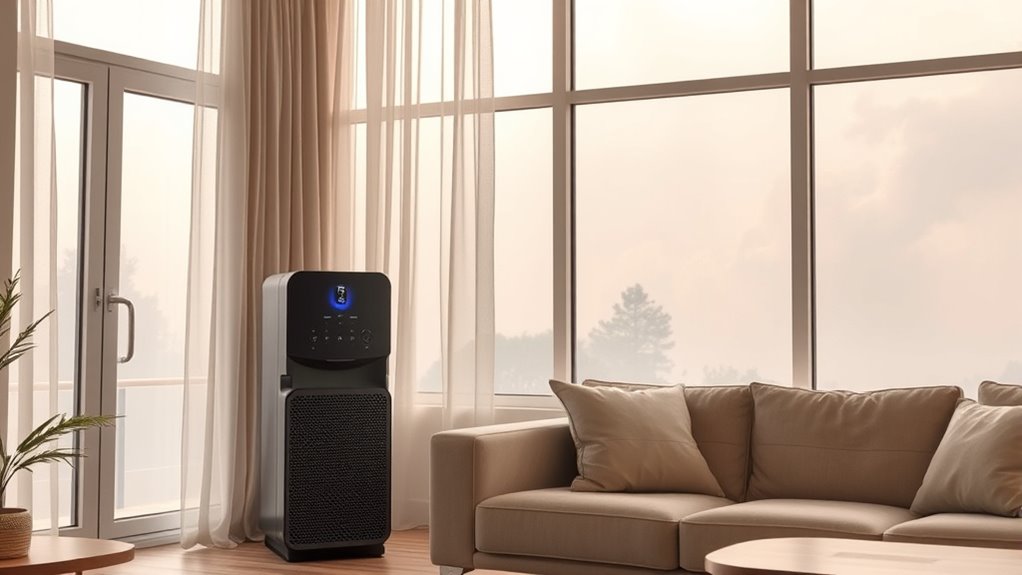
Enhancing indoor air quality during wildfires requires more than just maintaining your air purifier. You can boost your efforts with these strategies:
- Use indoor plants known for air purification, like snake plants or pothos, which can absorb toxins and improve air quality naturally. Incorporating sensory toys that promote relaxation and emotional well-being can also help mitigate stress caused by smoky environments.
- Monitor your indoor air with reliable air quality monitors to track smoke levels and adjust your ventilation or purifier use accordingly. Understanding airflow patterns within your home can help optimize filtration efficiency.
- Keep windows and doors closed during smoky days to prevent outdoor pollutants from entering, and ensure your home is well-sealed.
- Incorporating expert guidance on indoor air quality can help optimize your strategies and ensure a safer environment during wildfire seasons. Consulting local health authorities can provide additional tips tailored to your region.
- Incorporating these measures together can significantly reduce smoke infiltration and improve overall air quality inside your home. Utilizing high-efficiency air filters can further enhance your home’s defense against smoke particles.
Combining these approaches helps create a safer environment, reducing smoke infiltration and enhancing overall air quality. Staying vigilant with monitors and incorporating indoor plants offers a natural, effective way to protect yourself during wildfire seasons.
Choosing the Right Air Purifier for Your Home and Budget
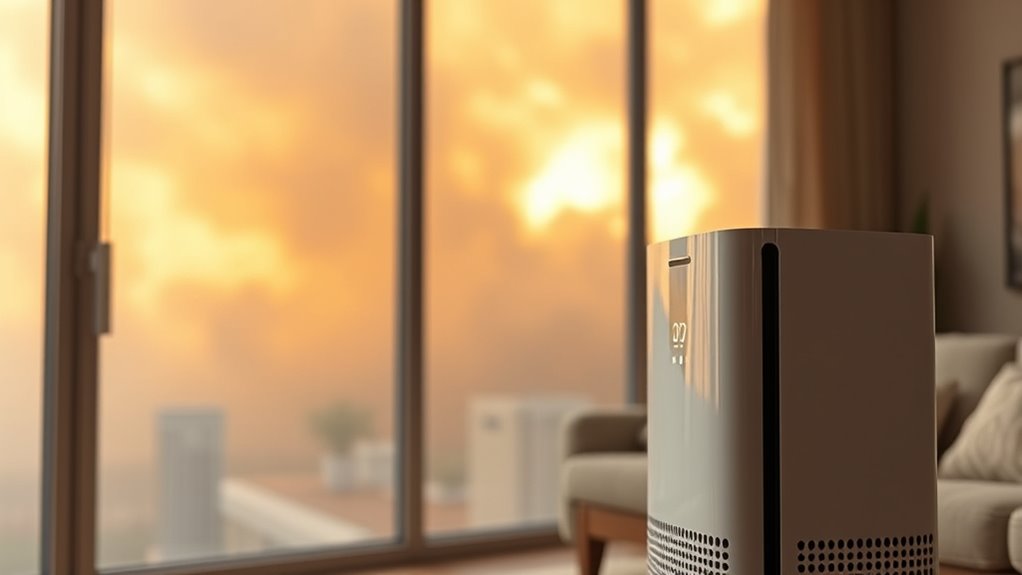
When choosing an air purifier, consider the filter types and how effective they are at capturing wildfire smoke. There are budget-friendly options that still improve indoor air quality, so you don’t have to overspend. Make sure the purifier’s size matches your room to get the best results. Additionally, selecting models with high-efficiency filtration can significantly reduce airborne pollutants, including fine particulate matter from smoke. Regular maintenance, such as filter replacement, ensures the purifier continues to operate effectively over time. Incorporating sound design techniques, such as low noise levels, can make the purifier more comfortable to run continuously without disturbing your environment. Proper placement and smart technology integration can further optimize performance and air quality.
Filter Types and Effectiveness
Choosing the right air purifier begins with understanding the different filter types and how effective they are at capturing wildfire smoke. HEPA filters are essential because they trap particles like ash, soot, and fine particulate matter, providing significant air cleaning power. Activated carbons are equally important, as they absorb gases, odors, and harmful chemicals released during wildfires.
- HEPA filters capture 99.97% of particles as small as 0.3 microns, including smoke and pollen.
- Activated carbon filters target gases, VOCs, and odors from smoke.
- Some purifiers combine both, offering all-encompassing protection.
Budget-Friendly Options Available
If you’re looking to protect your home from wildfire smoke without overspending, there are plenty of budget-friendly air purifiers that do a great job. Cost-effective solutions include smaller units or models with basic HEPA filters, which can efficiently reduce harmful particles. You can also explore DIY air filtering by using box fans combined with affordable filters to create simple, effective air cleaners. Consider the following options:
| Purifier Type | Key Features |
|---|---|
| Budget HEPA Units | Compact, energy-efficient, affordable |
| DIY Air Filtering | Customizable, low-cost setup |
| Portable Air Purifiers | Easy to move, budget-friendly |
These options help you safeguard indoor air quality without breaking the bank. Additionally, choosing appropriate filtration systems can significantly improve the effectiveness of your air quality measures. Proper filter maintenance and regular replacement are essential to ensure ongoing efficiency and health benefits. Maintaining good indoor air quality is especially important during wildfire seasons when smoke infiltration is more likely. Using HEPA filters can further enhance your protection against particulate matter. Regularly reviewing filter specifications ensures you select the most effective filtration for wildfire smoke.
Room Size Compatibility
Selecting an air purifier that fits your room size guarantees effective filtration without wasting energy or money. To guarantee optimal performance, you need to take into account your room size and the purifier capacity accordingly. Here are key points to guide you:
- Match the purifier’s capacity (measured in square footage) to your room size for maximum efficiency.
- Larger rooms require purifiers with higher capacity to maintain air quality during wildfire smoke events.
- Check the Clean Air Delivery Rate (CADR) to determine if the purifier can handle your specific room size effectively.
Choosing the right match prevents overworking the device and ensures you get clean, healthy indoor air during wildfire seasons. Proper sizing makes all the difference in your purifier’s performance.
Frequently Asked Questions
Can Air Purifiers Eliminate All Wildfire Smoke Odors?
You might wonder if air purifiers can eliminate all wildfire smoke odors. While they are effective at odor removal, no purifier can guarantee complete elimination of every smell. Smoke filtration systems, especially those with activated carbon filters, markedly reduce odors, but some stubborn smells might linger. To improve odor removal, choose a purifier designed for smoke filtration and run it continuously during wildfire events.
How Often Should I Replace Filters During Wildfire Season?
Think of your filters like a sponge soaking up dirt; the more wildfire smoke you face, the faster they fill up. You should replace filters more often during wildfire season, typically every 1 to 3 months, depending on your filter’s lifespan and your maintenance schedule. Regularly checking and following the manufacturer’s recommendations guarantees your purifier keeps working effectively to protect your indoor air quality.
Are HEPA Filters Sufficient for Wildfire Smoke Protection?
HEPA filters are generally sufficient for wildfire smoke protection, but be aware of their limitations. They effectively capture most smoke particles, reducing indoor pollution. However, some very fine particles can still penetrate HEPA filters, so you might need additional measures like airtight seals and high-quality purifiers. Regular filter changes are essential for maximum performance, especially during wildfire season, to ensure smoke penetration stays minimal and indoor air quality remains high.
Do Air Purifiers Produce Ozone or Other Harmful Emissions?
You might wonder if air purifier emissions, like indoor ozone, are a concern. Many air purifiers produce low levels of ozone, which can irritate your lungs and worsen asthma. To minimize indoor ozone, choose models labeled “ozone-safe” or those with HEPA filters designed to reduce harmful emissions. Always check product specifications to verify your air purifier doesn’t contribute to indoor ozone and maintains good air quality.
Can Portable Air Purifiers Effectively Cover Large Indoor Spaces?
Did you know that most portable air purifiers are effective in spaces up to 300 square feet? When considering a large room, your success depends on room size and air circulation. To maximize coverage, choose a purifier with a higher Clean Air Delivery Rate (CADR) and guarantee good air circulation by placing it centrally. This way, you’ll improve air quality effectively across your entire space.
Conclusion
Did you know that indoor air can be up to five times more polluted than outdoor air during wildfires? By choosing the right air purifier and maintaining it properly, you can markedly reduce harmful particles and gases inside your home. Protecting your indoor air quality isn’t just about comfort—it’s about your health. Stay vigilant, follow these tips, and breathe easier knowing you’re doing your part to stay safe during wildfire season.

